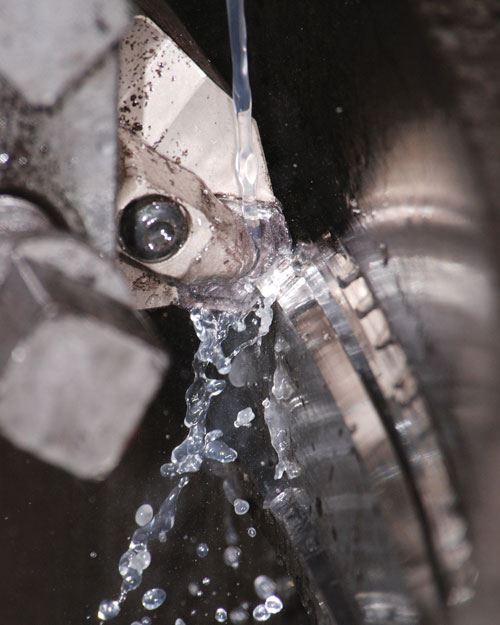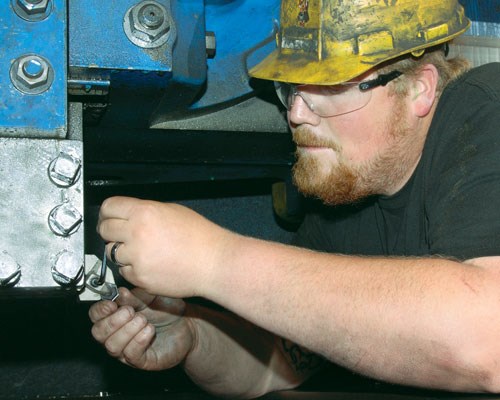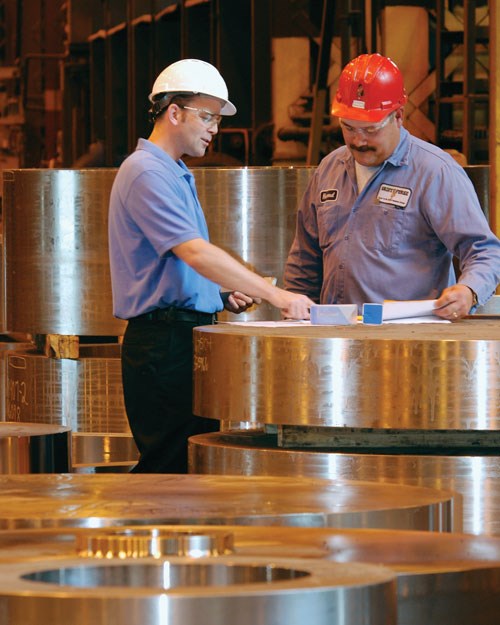Long-Lasting Insert Turns Around Tough Inconel Job
By changing to a hex-shaped turning insert with a 45-degree lead angle, this shop saved thousands of dollars on a difficult Inconel turning application.
Share





When inserts rupture in Inconel, the typical reaction is to “take the load off” the insert by lightening the cut, says Jim Whitley of cutting tool manufacturer Ingersoll (Rockford, Illinois). However, this reaction may be ill-advised. Shops tend to forget that rupture often begins with an edge going dull, which, in turn, overloads the insert to the point of breaking down. “This can happen within a few seconds, so it’s easy to miss wear as the root cause,” he explains. “Assuming that adequate machine horsepower is available, the better answer is to go to a stronger insert with a gentle lead angle and make fewer, deeper passes.”
Following Mr. Whitley’s advice paid dividends at Scot Forge, which saved $2,400 per part on one tough Inconel turning application after retooling to Ingersoll’s Hex-Turn inserts and adjusting machining parameters accordingly. Based on its success with that job, the company has standardized on Hex-Turn and those same parameters for rough turning a growing variety of Inconel parts.
Scot Forge is a diversified, employee-owned forging company that has been in business for more than 100 years. It has plants in Clinton, Wisconsin as well as Franklin Park and Spring Grove, Illinois. By customer preference, most of the company’s output is delivered in the forged and rough-machined condition.
Howard Dempsey is supervisor of the machine and saw shop at the Clinton plant, a site that runs 24 hours a day, five days a week and houses 200 employees, 50 of whom are machinists. He says the part that prompted the company’s switch to Hex-Turn is just one of a growing number of jobs involving high-temperature alloys, which management has identified as a trend. “We get about six reorders a year for that part, and orders for other Inconel and titanium forgings are rising,” he notes. “So, we decided it was time to develop a best practice for machining them.”
While taking on Inconel, titanium and other high-temperature alloys can provide a competitive advantage and a source of pride, these exotic materials are abrasive to tools and impose high cutting forces. Additionally, they tend to generate hot, stringy chips that can stick to the cutting edge and overheat the tool. As a result, such work can create bottlenecks, tie up machines and increase tooling costs.
That was the case with Scot Forge’s problem component, a huge Inconel No 7718 hub used in nuclear turbomachinery. This part requires rough turning and facing to remove about 0.8 inch of material across its entire diameter, primarily for truing up. As forged, it measures 98 inches in diameter, with a step-down to a 93-inch diameter on one end.
Previously, machining took 105 hours and 40 passes at a feed rate of 0.02 ipr, a cutting depth of 0.075 inch and a speed of 38 sfm. The turning and facing operations required different inserts, and the job typically ate through 69 inserts per part. In fact, tool failure was so prevalent that inserts required indexing every half inch, and the job had to be run 100-percent attended. Moreover, the main failure mode was edge rupture, which renders the insert useless even if some edges go unused. All the while, the operation tied up a large vertical lathe from MAG Giddings & Lewis (Fond du Lac, Wisconsin) that the company needed for other work.
With an eye toward a better standard practice for turning this class of alloy, Mr. Dempsey asked all his tooling vendors for their best ideas and began testing different solutions. Most tools the company tested produced minor improvements at best. The exception was the Hex-Turn, which features a 45-degree lead angle presentation and top-face chipbreakers. Tests showed these inserts could significantly improve cycle time and tool life compared to the square, flat-topped, zero-lead models the shop had been using.
The company standardized parameters for the new tool at an 0.015-ipr feed rate (slightly less than the previous rate), an 0.15-inch cutting depth (double the previous setting) and a speed of 60 sfm (60 percent higher than the previous setting). Despite more than doubling the cutting rate, each insert lasted through the whole part. Cycle time dropped 15 percent. “We would have been happy with just the tool life improvement,” Mr. Dempsey says. “The throughput gain was an unexpected bonus.”
Cutting deeper reduces the number of required passes, which, in turn, reduces the insert’s exposure to the hot, abrasive environment at the cutting edge. However, as Mr. Whitley explains, an insert’s ability to withstand a deeper cut depends on its strength. That’s why—true to its name—the Hex-Turn features a hexagonal geometry, a shape that is second only to round inserts in strength, he says.
Ingersoll product manager Raymon Avery adds that the other difference-maker is the 45-degree lead angle, which is made intrinsically possible by the insert’s hex shape and chipbreaker top face. This lead angle provides a gentler entry into the work that reduces cutting forces and protects the insert. Meanwhile, the contoured top face breaks up the long, hot, gummy chips characteristic of Inconel alloys and deflects them away from the insert to reduce heat.
In all, the drop-in retooling saved $1,500 in cycle time and $900 in tooling costs—per part. Cost savings aside, having a secure process for such difficult material enables Scot Forge to bid more confidently on Inconel jobs and to compete more effectively in a high-tech niche. “This improvement enables us to maintain competitive costs for machining Inconel,” Mr. Dempsey says. “Otherwise, we would have been forced to raise prices to cover the excessive cost of tooling and the resulting sub-par productivity.”
Read Next
Setting Up the Building Blocks for a Digital Factory
Woodward Inc. spent over a year developing an API to connect machines to its digital factory. Caron Engineering’s MiConnect has cut most of this process while also granting the shop greater access to machine information.
Read More5 Rules of Thumb for Buying CNC Machine Tools
Use these tips to carefully plan your machine tool purchases and to avoid regretting your decision later.
Read MoreRegistration Now Open for the Precision Machining Technology Show (PMTS) 2025
The precision machining industry’s premier event returns to Cleveland, OH, April 1-3.
Read More


















.png;maxWidth=300;quality=90)














